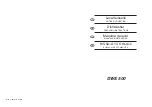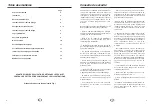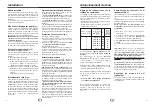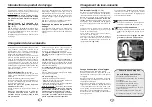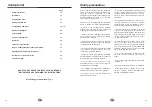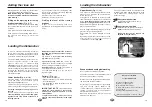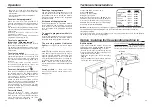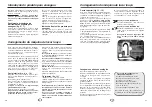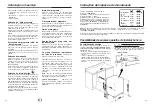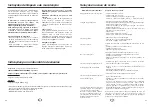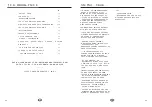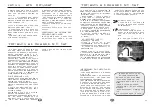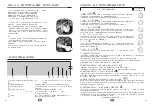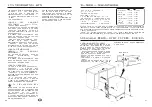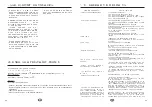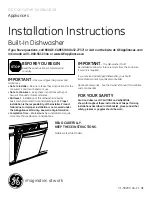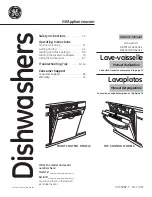
GB
19
Loading the dishwasher
Upper basket
(Fig. 11 - 12)
This basket is particularly intended to hold
glasses, cups, ramekins, small salad bowls,
bowls, saucers etc…
Place glasses so that they do not touch and tip
them sufficiently so that they do not retain any
water.
Place the hollow end of glasses, cups
and bowls facing downwards.
Arrange the
dishes methodologically to gain space (rows of
glass, cups, and bowls)
Use the height adjustable holding bar for large
glasses or large-stemmed glasses.
Cups, ladles, etc... can be arranged too on the
rack.
By varying the position of the baskets, you can
alter the layout of the rack to suit every
combination of crockery
(fig. 12B)
.
The upper basket should be adjusted to the
HIGH position when loading large plates in the
lower basket. The setting can be execute
basket in charge.
Setting the HIGH POSITION
Slowly lift the basket until you hear a
click
on each side.
Setting the LOW POSITION
Lift the basket completely on both sides
(click)
and then follow it downwards.
Make sure that the two runners are
adjusted to the same level.
CLICK
①
①
STOP
①
①
②
②
CLICK
②
②
Economical and ecological washing
Do not pre-wash your dishes by hand.
Use all the capacities of your dishwasher. It will
wash economically and ecologically.
Always choose the programme best adapted to
the stains and the type of dishes.
Avoid using too much detergent, regenerating
salt and rinsing liquid. Observe the
recommendations contained in this manual
(pages 17 and 18) as well as the product
manufacturer’s instructions.
Make sure that the water softener is properly
adjusted. (see page 17)
Objects not suitable
for your dishwasher
- Wooden chopping boards
- Pewter or copper objects
- Non-stainless steel objects
- Cutlery with wooden, horn or mother-of-
pearl handles
- Antique or hand-painted crockery
When buying dishes or cutlery, check
18
GB
Loading the dishwasher
Adding the rinse aid
Rinsing product is necessary as it avoids stains
on the dishes and makes drying easier.
IMPORTANT! Only use products intended
for dishes and NOT detergents intended for
hand washing !
Filling and adjusting the rinsing
product container (Fig. 6 - 7)
Put the door in a horizontal position when filling
the container and unscrew the cap in the door
clockwise.
Fill to just below the to the adjusting lever.
If the product overflows during filling, remove
the excess with a sponge to avoid foam
forming.
If you experience stains or bad drying after
several cycles, you may if necessary adjust the
dosage using the selector:
Soft water : level 1 to reduce the dose
Hard water : level 3 to increase it.
Finding the level of the rinsing
product.
A light on the control band shows you
requirements in rinsing product when the door
is ajar.
In order to obtain good cleaning results, be
sure to remove any large food residues before
switching on the machine. Any burnt or stuck-
on residues must be removed beforehand.
The model DWE 300 dish-washer has two
racks for 14 place-settings, or 162 items
(figures 10-11-13), to standard DIN
44990.Always point the inside of the crockery
downwards. Ensure that no item conceals
another and that nothing obstructs the spraying
facility. After switching on, check that the
spraying arms can move freely. No item should
overlap the baskets.
Lower basket
(Fig. 8 - 9 - 10)
Place the dishes so that water may circulate
freely and spray all the utensils. (Avoid
attaching and piling dishes up).
This basket is especially intended to hold:
plates, cutlery, dishes, frying pans, saucepans.
Put large-sized plates and frying pans on
the side.
Avoid mixing plates and soup dishes.
You
should preferably place same-sized plates
together. Place soup dishes at the back, in
the high pin area.
Make sure nothing obstructs the rotation of
the lifting arm (saucepan handles, cutlery or
large dishes).
The baskets in the
bottom rack fold away
(fig. 9B)
to take large dishes.
The cutlery trays slide
and can be put
anywhere on the lower basket. You can adjust
them according to the dishes you wash.
Removable grids
are available if you wish to
load cutlery in an orderly fashion.
For optimum washing, you can use these
separation grids.
Cutlery : (Fig. 13)
• Place handles downwards.
• Separate silverware from other metals using
the separating grill.
• It is preferable to place small spoons in the
separating grills.
IMPORTANT NOTE :
For reasons of
safety, we recommend you place sharp-
ended table knives blade down in the
cutlery basket.
Long-bladed cutlery and other sharp
utensils should be placed flat in the upper
basket
.
Summary of Contents for DWE 500
Page 2: ......
Page 28: ...14 15 9 10 11 9B 12 13 12B ...
Page 30: ...14 15 9 10 11 9B 12 13 12B ...

